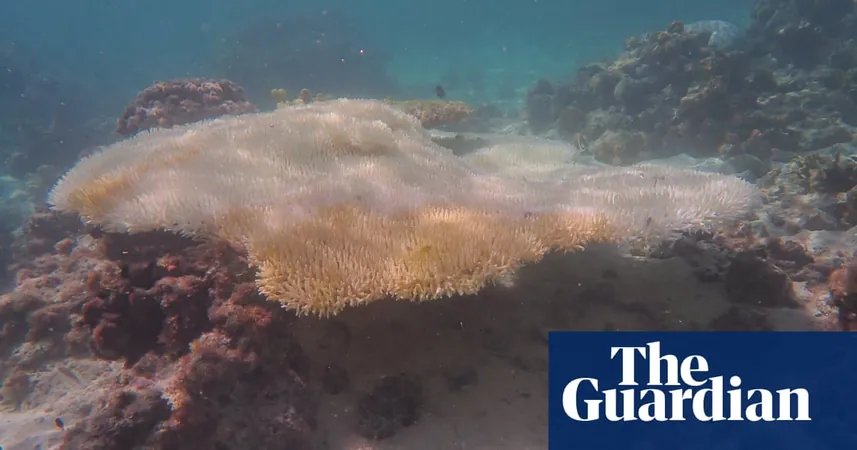
Catastrophic Coral Bleaching Strikes Great Barrier Reef: Are We Losing This Natural Wonder?
2025-01-21
Author: Emily
Introduction
A recent study has found that a staggering 40% of monitored coral colonies at One Tree Island, part of the Great Barrier Reef, succumbed to the most widespread coral bleaching event recorded in history. Researchers observed the devastating impact of heat stress on corals in early 2024 and described scenes as “catastrophic” on this once-thriving ecosystem.
The Bleaching Event
Only 92 out of the 462 coral colonies assessed managed to escape bleaching entirely. By July 2024, the data collection period for this study concluded with 193 colonies dead and an alarming 113 still displaying signs of bleaching. Prof. Maria Byrne, a marine biologist at the University of Sydney who has dedicated 35 years to studying this island, expressed her dismay: “Seeing those really massive colonies die was really devastating. We have been trying to get the message across about climate change for ages.”
Corroborating Evidence
The Australian Institute of Marine Science corroborated these findings, revealing that the Capricorn-Bunker sector of the reef recorded its largest annual decline in hard coral cover since monitoring began in the mid-1980s, plummeting by 41%. Similar patterns of coral loss were reported in the northern regions, where one government scientist likened the scene to a 'graveyard of corals.'
Research Methodology
The research team utilized temperature loggers, video footage, and direct observations to monitor the health of 12 different coral types. They pointed out that while corals can recover from mild bleaching when temperatures drop, the severe bleaching observed at One Tree Island is, unfortunately, far from mild.
The Goniopora Genus
One distressing observation focused on the Goniopora genus, known for forming beautiful, flower-like boulders, which not only bleached but also showed signs of a horrific flesh-eating disease known as black band. Dr. Shawna Foo, a co-author of the study, remarked on the stark transformation of the landscape: 'After tracking the corals for five months, it was hard to recognize many of the colonies, because they were either covered with algae, dead, or crumbling.'
Rising Temperatures
As March typically marks the peak for heat stress in the region, the Great Barrier Reef Marine Park Authority reported that temperatures across the marine park are currently averaging up to 1.2°C above normal. Alarmingly, the US Coral Reef Watch program has projected that parts of the reef north of Cooktown will face more intense heat stress and possible further bleaching as early as mid-February.
Increasing Mortality Rates
Richard Leck, head of oceans at WWF-Australia, emphasized the urgency of the situation: 'It’s clear there has been major mortality in areas from the north, and new research shows significant mortality in the south. The reef is under increasing heat stress, particularly in the north, raising the possibility of yet another back-to-back bleaching event. It’s a dangerous game of Russian roulette.'
Call for Action
With UNESCO requesting a report from the Australian government on the reef's condition by early next month, it is crucial that an accurate portrayal of the Great Barrier Reef's health be presented. There is a pressing need for increased efforts and resources dedicated to its protection. The deteriorating health of this UNESCO World Heritage site is a stark reminder of the larger, global threat posed by climate change, and a wake-up call that action is needed now more than ever.
Conclusion
Are we witnessing the decline of one of nature's greatest masterpieces? Only time will tell, but the signs are alarming, and the urgency is palpable.









 Brasil (PT)
Brasil (PT)
 Canada (EN)
Canada (EN)
 Chile (ES)
Chile (ES)
 Česko (CS)
Česko (CS)
 대한민국 (KO)
대한민국 (KO)
 España (ES)
España (ES)
 France (FR)
France (FR)
 Hong Kong (EN)
Hong Kong (EN)
 Italia (IT)
Italia (IT)
 日本 (JA)
日本 (JA)
 Magyarország (HU)
Magyarország (HU)
 Norge (NO)
Norge (NO)
 Polska (PL)
Polska (PL)
 Schweiz (DE)
Schweiz (DE)
 Singapore (EN)
Singapore (EN)
 Sverige (SV)
Sverige (SV)
 Suomi (FI)
Suomi (FI)
 Türkiye (TR)
Türkiye (TR)
 الإمارات العربية المتحدة (AR)
الإمارات العربية المتحدة (AR)